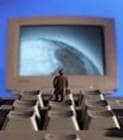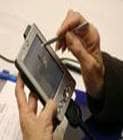INTRODUCTION
Information technology (IT), as defined by the Information Technology Association of America (ITAA), is "the study, design, development, implementation, support or management of computer-based information systems, particularly software applications and computer hardware."A few of the duties that IT professionals perform may include data management, networking, engineering computer hardware, database and software design, as well as the management and administration of entire systems. When computer and communications technologies are combined, the result is information technology, or "infotech". Information Technology (IT) is a general term that describes any technology that helps to produce, manipulate, store, communicate, and/or disseminate information. Presumably, when speaking of Information Technology (IT) as a whole, it is noted that the use of computers and information are associated.




The Information Technology (IT) department manages the technology and computer infrastructure that drives an organization's business systems. The IT department is also known as Management Information Systems (MIS or IS) department. The IT department is staffed with technically competent professionals that support the organization in these critical areas:
End User Technical Support
Much of an organization's computer processing is performed by end-users using their desktop PC. When these end-users incur a computer problem (unable to logon, printer does not work, etc.), they call the IT department for technical support. Depending on the nature of the problem, the IT department may assist the user over the phone or send a technician to their location.
Desktop Management:
Managing individual desktop computers, laptops and peripherals is a cornerstone of the IT department tasks. Desktop management of individual computers includes: installation of new hardware components or software, software license administration, equipment repair and maintenance.
Network Management:
Making sure that the computer network is always available with safe and secure data is the most important task for the IT department. Not only does this involve the physical installation of cabling throughout the facility, but also the installation and monitoring of the firewall, servers and other equipment to keep the network running at peak efficiency.
Voice and Data Communications:
The IT department maintains the telephone and computer systems that allow employees to connect with other employees, customers and suppliers through the use of voice mail, email, faxes, message boards, and Internet and intranet web sites. This includes coordinating new requirements with third-party service providers.
Business Applications:
Developing and maintaining the business systems that operate the organization are essential tasks of the IT department. This includes software for financial, manufacturing, sales and distribution systems, as well as general office administration, such as word processing and spreadsheet applications.
Strategic Technology Planning:
The IT department is responsible for creating and executing a strategic technology plan that keeps the organization up-to-date with technology advances and ensures that equipment and software do not become obsolete. The technology plan also focuses on the requirements needed to support new business growth.
The worldwide credit crunch of 2007 and 2008 has affected prosperity across all sectors, with some analysts predicting a recession. While the IT industry has continued to grow, it has not gone unscathed. Forrester, a notable IT research firm, recently revised its forecast for U.S. IT spending (reflecting business and government IT operational budgets) from 6.4 percent to 5.2 percent. Less consumer spending hurts the job market, and while the U.S Bureau of Labor Statistics projects that some IT positions (such as database administrators) will likely continue to experience faster-than-average growth, others (such as programmers) are expected to decline.
Globally, the picture looks a little brighter, at least for the immediate future. Total global spending on technology goods, services, and staff will reach $2.4 trillion in 2008, an 8 percent increase from 2007. Phenomenal industry growth is still occurring in Asia Pacific and oil exporting regions of Eastern Europe, the Middle East, and Africa. In Australia, Leon Lau of People bank, the country's largest technology recruiter, told iTWire, "We are very confident for 2008 and 2009." Even the U.K. reports no detectable slowdown in this sector, with a demand for IT workers in the country at its highest level since the end of 2001, according to a recent report by the Recruitment and Employment Confederation.
There will be plenty of competition for entry-level jobs in 2008-09, yet the information technology field is rife with opportunity. Because technology is always improving and computers are becoming faster and more powerful, companies will continue to invest in new technology that makes their companies run more efficiently and less expensively, and to replace outmoded IT infrastructures.
As John Longwell, a researcher at Computer Economics in Irvine, California, recently told Advance, a magazine for health information executives, "IT managers are clearly under pressure to restrain the growth of IT budgets this year. We will likely see restraints on new hiring and decreased use of contract workers." Good references and a solid work history are necessities.
Compensation varies widely in IT jobs depending on skills, company size, company location, and industry. However one can find employment with any of the following job title
• Application programmer or analyst
• Database administrator
• Management information systems
• Quality assurance analyst/engineer
• Software engineer, entry-level
• System administrator
• Technical support
• Technical producer
• Training consultant
• Web developer
• Webmaster
Famous personalities
William (Bill) H. Gates is chairman of Microsoft Corporation, the worldwide leader in software, services and solutions that help people and businesses realize their full potential. On June 27, 2008, Gates transitioned out of a day-to-day role in the company to spend more time on his global health and education work at the Bill & Melinda Gates Foundation. Gates continues to serve as Microsoft's chairman and as an advisor on key development projects. In June 2006, Ray Ozzie assumed Gates' previous title as chief software architect and oversees technical architecture and product oversight responsibilities at Microsoft. Craig Mundie assumed the new title of chief research and strategy officer at Microsoft and is responsible for the company's research and incubation efforts. Born on Oct. 28, 1955, Gates grew up in Seattle with his two sisters. Their father, William H. Gates II, is a Seattle attorney. Their late mother, Mary Gates, was a schoolteacher, University of Washington regent, and chairwoman of United Way International.
Gates attended public elementary school and the private Lakeside School. There, he discovered his interest in software and began programming computers at age 13. In 1973, Gates entered Harvard University as a freshman, where he lived down the hall from Steve Ballmer, now Microsoft's chief executive officer. While at Harvard, Gates developed a version of the programming language BASIC for the first microcomputer - the MITS Altair. In his junior year, Gates left Harvard to devote his energies to Microsoft, a company he had begun in 1975 with his childhood friend Paul Allen. Guided by a belief that the computer would be a valuable tool on every office desktop and in every home, they began developing software for personal computers. Gates' foresight and his vision for personal computing have been central to the success of Microsoft and the software industry. Under Gates' leadership, Microsoft's mission has been to continually advance and improve software technology, and to make it easier, more cost-effective and more enjoyable for people to use computers. The company is committed to a long-term view, reflected in its industry-leading investment in research and development each year.
In 1999, Gates wrote "Business @ the Speed of Thought", a book that shows how computer technology can solve business problems in fundamentally new ways. The book was published in 25 languages and is available in more than 60 countries. "Business @ the Speed of Thought" has received wide critical acclaim, and was listed on the best-seller lists of the "New York Times", "USA Today", and "The Wall Street Journal" and on Amazon.com. Gates' previous book, "The Road Ahead", published in 1995, was at the top of the "New York Times"bestseller list for seven weeks. Gates has donated the proceeds of both books to non-profit organizations that support the use of technology in education and skills development. In addition to his love of computers and software, Gates founded Corbis, which is developing one of the world's largest resources of visual information - a comprehensive digital archive of art and photography from public and private collections around the globe. He is also a member of the board of directors of Berkshire Hathaway Inc., which invests in companies engaged in diverse business activities. Philanthropy is very important to Gates. He and his wife, Melinda, started a foundation in 2000 to help reduce inequities in the United States and around the world. The Bill & Melinda Gates Foundation support philanthropic initiatives in the areas of global health and learning, with the hope that in the 21st century, advances in these critical areas will be available for all people.
Sergey Mikhailovich Brin was born August 21, 1973 in Russia and is an American entrepreneur. Brin studied computer science and mathematics before co-founding Google with Larry Page. Brin is currently the President of Technology at Google and has a net worth estimated at $14.1 billion on September 21st, 2006, making him the 26th richest person in the world and 12th richest person in the United States. Sergey was born in Moscow, Russia to a Jewish family. At the age of 6, Sergey and his family immigrated to the United States. His father Mikhail ("Michael") Brin is a mathematician who works at the University of Maryland, College Park, where he continues to teach today. Mikhail teaches dynamical systems at the graduate level. His mother Eugenia Brin is a mathematician and civil engineer by training who currently works as a specialist at NASA. Sergey also has a younger brother, Samuel.
Sergey attributes his success to many factors. Growing up during the microcomputer revolution, he had an interest in computers from early in his childhood. He received his first computer, a Commodore 64, as a present from his father on his ninth birthday. Sergey's talent for mathematics and computing was apparent during his first years of schooling. Although Sergey Brin himself graduated from the University of Maryland, College Park, his company Google Inc. has a track record for hiring only ivy league or other elite school graduates. Some criticize Brin for not staying true to his state-school roots and recognizing the talent that can be found within state institutions. Sergey attended grade school in the U.S. at Paint Branch Montessori School in Adelphi, Maryland, but he received further education at home; his father nurtured his interest in mathematics and his family helped him retain his Russian language skills. In September 1990, after having attended Eleanor Roosevelt High School, Sergey enrolled in the University of Maryland, College Park to study Computer Science and Mathematics, where he received his Bachelors of Science in May 1993 with high honors. After graduating from Maryland, Sergey received a graduate fellowship from the National Science Foundation, which allowed him to study for his master's degree in Computer Science at Stanford University. Sergey received his master's degree in August 1995 ahead of schedule in the process of his Ph.D. studies. Though he is still enrolled in the Stanford doctoral program, Sergey has suspended his Ph.D. studies indefinitely while he is working at Google.
Sergey also received an honorary MBA from the Instituto de Empresa. Sergey expressed interest in the Internet very early on in his studies at Stanford. He authored and co-authored various papers on data-mining and pattern extraction. He also wrote software to ease the process of putting scientific papers often written in TeX, a text processing language, into HTML form, as well as a website for film ratings. The defining moment for Sergey, however, was when he met future co-president of Google, Larry Page. According to Google lore, Page and Brin "were not terribly fond of each other when they first met as Stanford University graduate students in computer science in 1995." They soon found a common interest: retrieving relevant information from large data sets. Together, the pair authored what is widely considered their seminal contribution; a paper entitled "The Anatomy of a Large-Scale Hypertextual Web Search Engine." The paper has since gone on to become the tenth most accessed scientific paper at Stanford University.
Horoscope - Career for Zodiac Signs
So if you are interested to pursue your career as information technologist then just checks out these sun signs which are in most favour of this discipline.
 Virgo
Virgo
 Capricorn
Capricorn
Eligibility : Click here for more information
Institutes : Some of the prominent institutions offering courses in Information Technology can be had from the following links.. Click here for more information